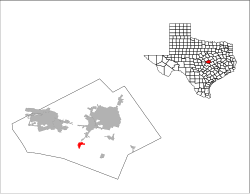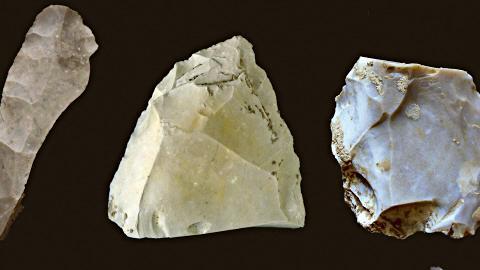Buttermilk Creek Complex
30.903403 - 97.665968Koordinaten: 30 ° 54 ' 12 " N, 97 ° 39' 57 " W
As Buttermilk Creek Complex (German: Buttermilk Creek Complex ) is an archaeological find horizon from the Paleo-Indian period along a dry Buttermilk Creek, southwest of Belton in Bell County ( Texas) referred, published by the in 2011 the previously oldest evidence of human settlement of the Americas were. The site Debra L. Friedkin site is located just 250 meters from the famous Place Fund since 1929 Gault site of the Clovis culture away. Known as the Buttermilk Creek Complex Fund layer is stratigraphically deposited directly beneath a layer of the Fund Clovis culture here. Thus, the long -time popular is " Clovis -first " theory now disproved in a direct stratigraphic sequence.
The fund leading layer was determined using optically stimulated luminescence ( OSL) dated to 15500-13200 years Before Present. The 18 data were measured on crystals from these sediments, the said age range in each case represents the minimum age of the samples. Even by including systematic measurement error, the finds predate the Clovis culture.
Finds
The Buttermilk Creek is characterized by the fact that his course of a decomposition of Edwards Chert follows a particularly suitable for the production of stone tools of flint. The excavations were begun in 2006 by a team led by archaeologist Michael Waters from Texas A & M University. The stone tools found since then include 56 units ( retouched artifacts), hundreds of thousands of discounts and manufacturing waste. The total of 15,528 stone artifacts consist of " Chert " ( fine-grained flint) of the nearby Edwards Plateau all but one. The exception is a partially polished piece of hematite. They were found embedded in a 20 cm thick layer in clay sediments of the dry creek bed, which was a thin, 2.5 cm thick layer of artifacts of the Clovis culture.
Among the finds are twelve finished, begun and broken projectile points with double-sided edge retouching, but still without the characteristic of Clovis points surface retouching. In any case here is also characteristic of Clovis basal Schäftungsrinne the " Fluted Points" available. It is concluded that this is a precursor to the Clovis culture. After the immigration across the Beringia land bridge at the end of the Wisconsin glaciation ( the last glaciation of North America ) the Clovis culture with the typical Fluted Points therefore was not brought from Asia, but only south of the large Laurentide ice sheet from the Buttermilk Creek Complex developed. This corresponds to that sent all found in Alaska Fluted points are significantly younger. With the data of the Debra L. Friedkin site, this resulted in " a generous period of time " for the people " to take residence in the North American environment to colonize South America to develop the Clovis tools and to create a population basis, in which the Clovis could spread technology. "
Other artifacts were blades and a core whose form was created, were cut off as finer tools of a block of stone.
A detailed analysis compared the findings of the Buttermilk Creek Complex, directly above the Clovis layer at the same locality and the Clovis finds from the neighboring Gault locality. It was found, however, that the nature and frequency of stone tools and from editing splitters are closely related both with the nearby Clovis findings also have statistically significant differences. This theses were refuted, who criticized after the first publication in 2011, that the Buttermilk Creek Complex had been misfiled. Thus, it was stated that the findings not about a tool before Clovis culture, but about Clovis finds, which were ship into deeper layers due to the special conditions in the local Vertisol soil. These assumptions have been allayed. Rather, the relationship between BCC and the Clovis finds the immediate neighborhood is exactly the same, one can expect when a culture is evolving at a later.
Assessment
The Buttermilk Creek Complex is remarkable for the very consistent for the OSL method data series. If the data are classified as relevant, they are also older than those determined by radiocarbon dating age of the pre- Clovis finds from the Paisley Caves in Oregon with an age of 14,300 years BP, Meadowcroft in Pennsylvania ( 14555-13955 calBP ) or the locality Monte Verde in Chile ( 14000-12000 BP), which would make the Buttermilk Creek Complex to the previously oldest archaeological horizon of America.
According to an opinion of the expert Gary Haynes ( University of Nevada ) for the journal Science, however, radiocarbon dates would be important to be sure about the pre- Clovis dating.










